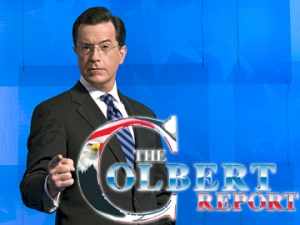The Art of Parody: Imitation With a Twist
We see parodies all over the place, especially in literature, film, and television, but what makes a good parody? How do parodies work? A parody is an imitation with a twist. In other words, a good parody is a humorous or ironic imitation of its source. The funniest parodies are those that most closely imitate the form which they mock. This requires careful attention to detail. As a result, parodies can be best appreciated by a niche audience–fans, or, at least, close observers, of the original. To fully understand the scope of parody as an art form, we need to consider parodies throughout history, various strategies used in parody, and the difference between visual and textual parodies.
Parodies in History

Parody is not just a modern phenomenon. In the early 19th century, Jane Austen’s Northanger Abbey parodied the style of Gothic fiction, which is full of horror and the supernatural. In the 18th century, Henry Fielding’s Shamela parodied Samuel Richardson’s Pamela, an epistolary novel about a maid servant virtuously resisting the advances of her employer. During the same era, Alexander Pope’s “The Rape of the Lock” parodied the epics like the Aeneid. In the 17th century, Miguel de Cervantes parodied the style of Spanish picaresque romances in Don Quixote.
In the 14th century, Geoffrey Chaucer’s “Sir Thopas’ Tale” in The Canterbury Tales is a parody of romances, like the first tale in the collection, “The Knight’s Tale.” What all these examples have in common is that the humor is lost on those unfamiliar with the source being parodied. While early readers of Pope’s “The Rape of the Lock” thought it was hilarious, modern readers will likely find it incredibly dull, unless they realize that it is a mock-epic. Pope parodies epic conventions like the invocation of the Muse and the arming of the hero, but to tell the totally non-epic story of a man cutting off a lock of a woman’s hair. Similarly, modern readers unaware of the style of Spanish picaresque romance might fail to detect the parodic elements in Don Quixote. If you have never read any Gothic fiction, the humor of Northanger Abbey will be unclear.
Parody is at least as old as ancient Greece. At Athenian dramatic competitions renowned dramatists like Sophocles and Euripides sought to produce the top plays. Each playwright submitted a tragic trilogy, along with a “satyr play,” which parodied the characters depicted in the serious tragedies. The ancient Greeks, therefore, enjoyed parody as much as tragedy.
Russian literary theorist and philosopher Mikhail Bakhtin explains that heroic figures like Odysseus and Hercules were mocked in the satyr plays. In “From the Prehistory of Novelistic Discourse,” Bakhtin writes, “It was the motif of madness that switched the figure of Odysseus from the high and straightforward plane to the comic plane of parody and travesty” (54). Odysseus feigned madness in an attempt to avoid fighting the Trojans. In satyr plays, Odysseus’ madness was exaggerated. This is the ancient Greek equivalent of Seth Rogen-style physical comedy. Similarly, Hercules was portrayed in the satyr plays as the “monstrous glutton, the playboy, the drunk and scrapper, but especially Hercules the madman” (54-55). The satyr plays took elements of Hercules’ persona and exaggerated them. Yet, this was not considered blasphemous, as it might be for an American to write a play making fun of George Washington or Abraham Lincoln.
Modern Parodies
A more recent example of parody is the web site Reductress, which satirizes women’s magazines. Reductress closely imitates the same visual style of a typical women’s magazine, like Cosmopolitan. Cosmopolitan‘s web site features tabs for “Love,” “Celebs,” “Beauty,” and “Fall Fashion.” On the Reductress home page, there are color-coded tabs for “News,” Living,” “Entertainment,” “Style,” “Love & Sex,” “Thoughts,” “Womanspiration,” and “R Network.” While the first five tabs are fairly typical of topics in women’s magazines, “Thoughts” and “Womanspiration” hint at parodic exaggeration. Stories like “7 Tips to Become Your Therapist’s Favorite Patient” parody the sub-genre of “Tips” articles that use a list format to offer advice that is usually banal, such as Cosmopolitan‘s “The 10 Best Things About Make-Up Sex”. Parodies fail, therefore, when they pay insufficiently close attention to the details of their source. The closer the imitation, the better the parody. While non-fans may see little difference between Star Trek and Star Wars, a good parody is specific enough that the difference is clear.
Bakhtin argues that parodies are latent in the original. Bakhtin says, “It is our conviction that there never was a single strictly straightforward genre, no single type of direct discourse—artistic, rhetorical, philosophical, religious, ordinary everyday—that did not have its own parodying and travestying double, its own comic-ironic contre-partie” (53). In other words, parodies are like the shadows of the thing they parody. Not only can anything be parodied, but as soon as someone creates art–any kind of art–the parody already exists in theory because it derives from the style of the original. As soon as George Lucas made Star Wars it became possible for Mel Brooks to make Space Balls. No single parody, of course, can exhaust the potential for parody. Different parodies may focus on various aspects of the source. While some parodies might be holistic, other may only parody a single element from their source. Galaxy Quest, for instance, is a holistic parody of Star Trek, as it parodies the visuals, plot devices, character types, etc. from Star Trek. In contrast, many different films have parodied Dr. McCoy’s signature phrase, “I’m a doctor, not a . . .” even if they do not parody anything else from Star Trek. Beyond these kinds of differences of scope, parodies also differ in strategy.
Exaggeration, Inversion, and Trivialization
Parodies can follow a number of different strategies. One might call three of the most common strategies exaggeration, inversion, and trivialization. Although these are somewhat fluid concepts and overlap in many parodies, they are useful in discussing the differences between parodies.

Exaggeration takes an aspect of the original, serious version and pushes it to the extreme. In Tropic Thunder, for instance, Robert Downey Jr.’s character, Kirk Lazarus, is a parody of Hollywood method-acting. Method actors are meticulous in their preparation to play a role and inhabit the characters they play even when they are not filming. Daniel Day-Lewis, for instance, caught pneumonia while filming Gangs of New York because he only wore period-accurate clothing. Tropic Thunder parodies this intense level of commitment.
As a white man playing a black character, Lazarus acts as if he is African American. Lazarus wears make up to darken his skin and uses black English. Tropic Thunder, thus, exaggerates the behavior of method actors. Connecting method acting to the racist tradition of blackface minstrelsy made some audiences uncomfortable. Comedian Frank Caliendo’s incredible vocal impersonations are another example of exaggeration. Caliendo imitates people, like John Madden, who tends to make ridiculous, tautological statements. Caliendo exaggerates Madden’s fixation with Brett Favre and his tendency to repeat at the end of the sentence what he said at the beginning.

Stephen Colbert’s character on The Colbert Report was a masterful example of exaggeration. Colbert adopted the persona of conservative pundits like Bill O’Reilly, Sean Hannity, and Glenn Beck. All of the shows visuals–the red, white, and blue color scheme of his set, the eagle in the opening credits–are designed to exaggerate conservative talking heads’ rhetoric about patriotism. At times, Colbert took his parody beyond his show, such as at a Congressional hearing on agriculture and migrant labor.
Colbert performs a parody of conservative views on immigration, which focus on securing the border and free market solutions. Colbert parodies the views of small-government conservatives by saying, “I’m not a fan of the government doing anything” and “Even the invisible hand doesn’t want to pick beans,” referring to Adam Smith’s notion of the free market as an invisible hand. Colbert exaggerates the anti-immigration position of some conservative politicians, who fail to acknowledge that America’s earliest settlers were immigrants: “My great-grandfather did not travel across 4,000 miles of the Atlantic Ocean to see this country overrun by immigrants.” He ends his remarks with parodic patriotism, saying, “U.S.A. Number one.”
Inversion involves flipping the terms in an accepted system of values–good becomes bad, bad becomes good. Many of the articles in The Onion use inversion as a strategy. In one such article, “Museum Of Repressed American History Conceals New Exhibit On Tuskegee Experiments,” The Onion treats the concealing of historical atrocities, like the experiments in which African Americans were infected with syphilis without their consent, as if it is normal. Sometimes inversion works not by switching bad for good, but by swapping the unexpected with the expected. Another article from The Onion, “Gay Teen Worried He Might Be Christian,” works precisely this way. The article flips the more controversial identity (being gay) with the less controversial one (being Christian). It follows the format of a story about the existential difficulty of a teenager struggling with the decision to come out, except the terms have been inverted. The humor lies in the glimpse the article gives us of a world in which it is more controversial to be Christian than gay, the opposite of current attitudes.
Trivialization consists of taking a serious topic and treating it as if it is silly or insignificant. Pope’s “The Rape of the Lock” is a classic example. Weird Al’s parodies also follow this strategy. Weird Al replaces a song’s original lyrics with much sillier lyrics that fit the melody. “I Love Rocky Road,” for instance, trivializes the passion of Joan Jett’s “I Love Rock n’ Roll.” Christopher Guest’s “mockumentaries,” such as A Mighty Wind, Best in Show, and This is Spinal Tap, typically employ trivialization. Guest portrays folk music, dog competitions, and heavy metal in the silliest terms possible. Bored of the Rings trivializes the fantasy tropes of Tolkien’s Lord of the Rings. Austin Powers trivializes the action sequences, intensity, and casual sex of the James Bond franchise. One of Dr. Evil’s henchmen, Random Task, is a parody of Oddjob from one of the early Bond movies, Goldfinger.

Another form of trivialization common in parodies of genre fiction draws attention to a lack of realism in the original. Parodies of science fiction, fantasy, and espionage typically employ this strategy. Whereas these genres normally ask us to suspend our disbelief, their parodies force us to disbelieve. A recurring joke in the spy parody Archer, for instance, involves characters experiencing excruciating pain and temporarily losing their hearing when someone fires a gun near their ears. While James Bond never seems fazed by all of the gun fire and explosions around him, Archer draws attention to the fact that a normal human response would be to experience ringing in one’s ears. JibJab’s video, “It’s Time for Some Campaignin'” about the 2008 presidential election trivializes the candidates by caricaturing their negative qualities. The music in the video is a parody of Bob Dylan’s “The Times They Are A Changin.”” JibJab trivializes John McCain’s rhetoric about fundamentalist Islam–“The Jihad needs containin'”–as well as Barack Obama’s campaign slogan–“I’ve got one or two things to say about change, like the change we must change to the change we hold dear. I really like change. Have I made myself clear?” (The repetition of “change” is also an example of exaggeration). The image of Obama riding a unicorn trivializes the idealistic, hopeful emphasis of his campaign.
Visual Parodies

Parodies, of course, can be visual, not just literary. The “Change into a Truck” poster, for instance, features the Transformer Optimus Prime with the red and blue design of Obama’s “Hope” campaign poster designed by Shepard Fairey. This parody follows the exact color-scheme and layout of the source, substituting Optimus Prime for Obama. Similarly, the Star Wars Coffee logo uses the same green and white color scheme from the Starbucks logo, substituting the head of a Storm Trooper for the Starbucks siren. As both of these images reveal, often only subtle changes are required to create an effective parody. While these two parodies seem harmless, others can be quite offensive.
siren. As both of these images reveal, often only subtle changes are required to create an effective parody. While these two parodies seem harmless, others can be quite offensive.
Parodies of religious figures, such as the infamous Danish cartoons of Muhammad, which feature Islam’s greatest prophet with a bomb for a turban, often ignite controversy. These parodies had a satirical edge: raising questions about the connection between Islam and violence. Parody and satire are not identical, though they are closely related: parody is a form of ironic imitation, whereas satire is an ironic form of social criticism. The Star Wars Coffee logo is a non-satirical parody, since it does not convey social criticism, but merely imitates the Starbucks logo. (There can also be satire that is not a parody because it does not imitate the style of another source.)
While some consider it healthy to poke fun at major religious figures like Moses, Jesus, and Muhammad, some devout believers find this incredibly offensive. Islamic terrorists, for instance, shot several people at the offices of the leftist French satirical newspaper Charlie Hebdo for its caricatures of Muhammad. Defenders of Charlie Hebdo advocate the right to freedom of speech and point out that the newspaper satirizes various religious traditions, rather than singling one out. Opponents of Charlie Hebdo (though not, of course, defenders of the shooting) argue that their parodies tend to be excessively crass and disrespectful of others’ beliefs. Parody has not always been perceived as offensive or threatening. In earlier eras, especially in ancient Greece and Rome, parody was essential. As discussed above, the same Greek playwrights who wrote tragedies also wrote parodies. Whereas many modern parodies are perceived to be antagonistic to their sources, ancient Greeks were comfortable laughing at their most important myths and heroes.
Many Americans treat American history as if it is quasi-sacred and should not be mocked. While a Facebook News Feed version of World War I and World War II trivializes pivotal historical events, it also translates the past into terms that people can understand. This parody uses trivialization by reducing the decisions of the Allied and Axis powers to Facebook statuses. This could also be called colloquialization because national policies are translated into the informal language of slang. Nevertheless, it captures the most significant moments of these global conflicts and the humor makes historical details memorable.
Some parodies may employ other strategies beyond exaggeration, inversion, and trivialization, but all parodies closely imitate elements of the source in an inappropriate context. A final way of thinking about parody is maintaining the form or style, but changing the content. Parodies offer unexpected content in familiar packages, like ketchup in a tube of toothpaste.
Regardless of whether a parody is visual or textual or whether it employs exaggeration, inversion, or trivialization, any good parody is an imitation with a twist–a humorous or ironic imitation of its source. While some parodies are harsher than others or more antagonistic toward their sources, parodies can be found in every era and every artistic medium.
Works Cited
Bakhtin, Mikhail. “From the Prehistory of Novelistic Discourse.” The Dialogic Imagination. Ed. Michael Holquist Trans. Caryl Emerson and Michael Holquist. Austin: U of Texas P, 1981.
What do you think? Leave a comment.











The art of parody will live forever.
This actually feels to me like a Golden Age in parodies in movies. You have the Cornetto movies, Kingsmen (and, to a lesser extent, The Man From U.N.C.L.E), the tragically underrated Tucker & Dale vs Evil and Attack the Block, and Cabin in the Woods (these are just what I can name off the top of my head). Most of these aren’t hard comedies, but they’re very smart and mildly comedic spotlights on well-established genres of films, much in the vein of Scream. Correct me if I’m wrong, but aside from Mel Brooks you didn’t get a lot of these types of movies in the late 80’s/early 90’s.
Tucker & Dale vs Evil is great! Cabin in the Woods and Scream are awesome too. It’s always good when horror parodies strike the right vein of humor and creating fear. They deconstruct the genre in just the right way without needing too many non-horror pop culture references to try and be funny. (I’m thinking of a hefty portion of the Scary Movie franchise.)
The frequency of parodies definitely varies by decade, although there were certainly lots of parodies in the ’80s and ’90s. This Is Spinal Tap came out in 1984. The Naked Gun movies came out between 1988 and 1994. Three Amigos was 1986.
I don’t think modern parody movies are bad, just different. Older parody was meant to mirror the original content with a comedic twist but the comedy was a lot deeper and intelligent. That lead to creating lots of memorable characters and scenes that are still referenced today. The modern “scary movie” style parodies are made for more of a quick laugh that requires little to no thought to understand. These movies are usually only good the first time you watch them and are considered terrible after multiple viewings since seeing it again gives the viewer time to think about the humor and realize how shallow it is. This doesn’t make these movies bad though, they serve their purpose of giving viewers an hour or two to just relax, stop thinking, and laugh at something stupid. Not all movies are meant to be a work of art and I don’t think its that hard to spot the movies that are made to be nothing more than mindless entertainment.
One problem with spoof movies lately is that they’re making fun of comedies. They’re taking something that already is funny and trying to turn that into something funny. The reason scary movie superhero movie and spaceballs worked is because they took something serious and turned it into something funny. I wouldn’t be surprised if we got a spoof movie of spoof movies
We might consider 30 Rock a “spoof of a spoof,” since it’s inspired by the behind-the-scenes of Saturday Night Live.
So parody can be a sort of “What if?” scenario, but less on alternate universe and more on humor?
That is an interesting way to think about it Anabel. Bakhtin might say that every work of art–every human utterance–contains within it the possibility of infinite different parodies. So, yes, we might think of the source material as a kind of Earth Prime and a parody as an alternate universe. Bizarro, of course, is a parody of Superman.
This was extremely interesting to me. There are so many parodies out there, I think that it’s only going to increase. In the realm of film, I have been beginning to feel like they run out of things to do so they make sequels and remakes. However, I think a lot of people would prefer to watch a parody movie rather than a remake. Yes, remakes can breathe new life into an old classic, but with a parody it’s going to be different. It is not going to be the same exact story told again. I personally get tired of watching remake after remake. I say, take a movie, make a parody. But draw the line before it becomes a farce. I think parodies should be funny but they need to be smart-funny. In the TV show Family Guy it’s parody after parody but they’re done in smart ways even though the show is kind of a farce. So far, that’s the only example where I can say it works both ways.
I think parodies are a great way to give exposure to a certain event or work that many people may not have heard of.
I think that this author has addressed the progress of parodies in a very thoughtful and organized manner. I’ve recently read and discussed both Geoffrey Chaucer’s “The Canterbury Tales” and Alexander Pope’s “Rape of the Lock” in my British Literature class. Many literary works sought to satirize the medieval society and/or the feudal estate, which included the clergy, and the nobility. I’ve noticed as we head into another genre of writing that we also use satirical works to create other implausible work. For example, Daniel Defoe’s “Moll Flanders” takes the mock epic of “Wife of Bath” and aligns the Wife of Bath and Moll Flanders. Although the novel belongs to the formal genre and is characterized by plausible plots, convincing characters, recognizable times and places, and referential language we see little implausibility. We see a rewritten version of “Wife of Bath.” My question is: is “Moll Flanders” a parody about Chaucer’s estates satire? That would be something worth exploring.
Great article on parodies! I learned some new sites to investigate like Reductress. I laughed out loud with The Onion’s article about being gay and perhaps a Christian-hilarious.
You stated: “The satyr plays took elements of Hercules’ persona and exaggerated them. Yet, this was not considered blasphemous, as it might be for an American to write a play making fun of George Washington or Abraham Lincoln.”
However, I would like to offer a “blasphemous” title here; Abraham Lincoln: Vampire Hunter (2012). IMDb categorized the film as a US product; so, it appears Americans were involved in this parody of Lincoln. I really enjoyed this movie and many of the audience members were in full costume which made it even more blasphemous!
Keeping in the Zombie genre I would like to add some titles such as the Pride and Prejudice and Zombie series in addition to Sense and Sensibility and Sea Monsters.
Fortunately, we are surrounded with parody if we take a moment to notice.
Thanks for this great piece.
That is a good point about Abraham Lincoln: Vampire Hunter. Some Americans are certainly comfortable parodying a revered president. However, even Abraham Lincoln: Vampire Hunter maintains Lincoln’s stature as a hero, whereas in the satyr plays Greek heroes were portrayed as madmen and drunks.
The best parodies can also serve as good examples of the things they’re parodying.
As long as MAD Magazine is still being printed, parody is still alive.
Simply put, satire is about respect…paying homage to the thing you’re satirizing while at the same time acknowledging the problems it has.
Excellent exposition.
Parody is a genre fundamental to 20th century art forms.
This is lovely!
I want to make a parody movie now…
Just have fun with the content you’re parodying, that’s the key.
Excellent examination of a seriously underlooked form of conveying a message. Your analysis is great and so is your writing!
Thanks!
Great post!
Wow, it was a great read 🙂
Definition of parody is much broader than one would think.
A thoroughly enlightening, well-constructed, and entertaining essay. The definition of parody is spot on; the emphasis on the need for prior knowledge in order to appreciate the writing is essential, and the types of parody as presented are extremely eye-opening. The whole is driven home by the Star Wars- Spaceballs reference.
Thanks!
I LOVE parodies. I find them clever. Don Quixote is my favorite book. I have no knowledge of what is parodies, but I found it clever and hilarious. I have also never met another person who has read and loved this book 🙁
This was such a cool article! I took a political communication class last semester so while I read this I was thinking of it through that lens. In the U.S. we are privileged to have freedom of speech and the right to openly mock and criticize our leaders because it’s obviously not the case in other countries. The issue becomes what is or isn’t acceptable when it comes to things like parody of a religion or group of people, especially if they are marginalized in society to begin with. The Colbert Report was a good example of political satire show whose strategy is very effective in engaging young people who are beginning to form their opinions on issues and starting to vote because it’s not only entertaining but informative. Even in a not so political context, parody is of course meant to invoke humor and it is appreciated for its creativity. It’s like a big cultural inside joke.
The great thing about “The Rape of the Lock”, as a parody, is that there are two levels to the parody. The first is the level that you described in your article. The second is the real-life context that caused the creation of the poem. In the Norton Anthology, the poem is accompanied by a letter from Pope to a woman in which the poem was intended. One of Pope’s friends took a lock of that woman’s hair, and the woman was insulted by the act. Pope intended to smooth things over with that poem, in effect trivializing the act of snipping a lock of hair (the letter explains it in greater detail).
I love parodies so it was very interesting to hear about the origin of them! This was definitely and incredible article.
I learned a lot from your article. It was very informative and since I love political satire and irony I will be checking out some of the magazines ands shows you have mentioned.
Thanks for an article written with great style.
I love this!
I remember reading “Dinner with Trimalchio” in a Latin class, and our professor told us that we wouldn’t think it was funny unless we understood the references and how things were according to the time. When you mentioned “The Rape of the Lock” it took me right back to that.
Very interesting. I didn’t realize parody began so long ago.
The participants in the Tuskegee Study were not infected with syphilis. They already had syphilis prior to the study but they were not told by the doctors they had it or treated for it.
My mistake. Thanks for fact-checking.
I lovee the visual parodies, particularly because it often reminds me of Dadaism. Also, i love when texts mock inwards, breaking the fourth wall, or self-parodies, its so classic.
This was a well-organized and well-written article that traced the trajectory of parodies in literature, film and even online (And there’s so many more examples like Dr. Strangelove or even The Pink Panther films and series). But, where (if at all) does the term Parody and Satire cross in many of these examples? Would love a discussion that can help finalized the absolute difference between both. Great article!
I would say that satire is motivated by a desire to change society, whereas parody simply entails imitation or exaggeration. Veep is a satire of political culture because it suggests that we would have a better society if politicians were less petty and egotistical. Frank Caliendo’s impressions of various celebrities are parodies, but not satire. The Colbert Report is both parody and satire because Colbert imitated a conservative pundit while also pointing out various flaws in our society.
Don’t forget The Rutles…
Recalled loved reading about this topic. It was really interesting to hear about all the ways in which parodies come to be and even how we can relate to them today. Also, the many aspects to parodies was something really interesting as well to know.
*Really